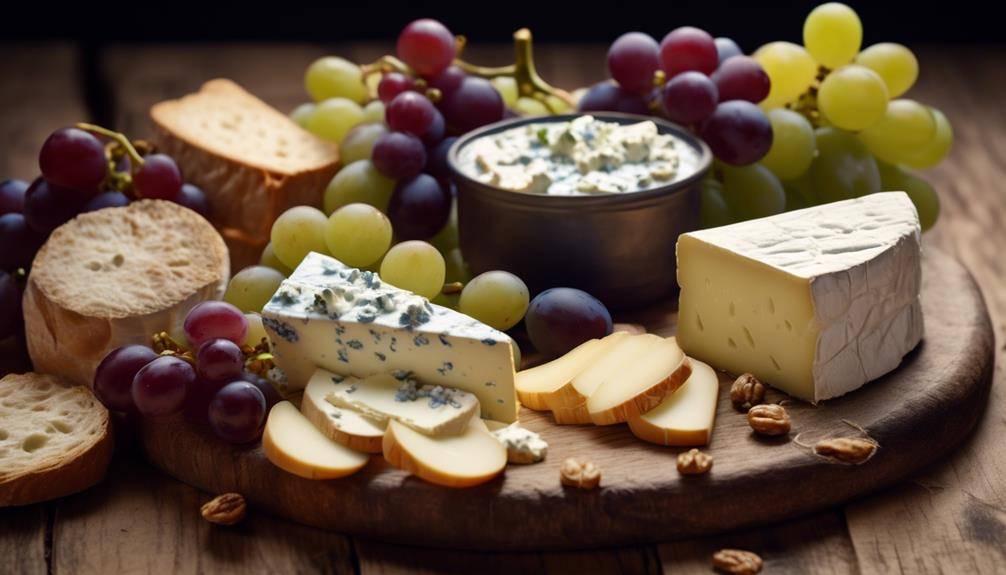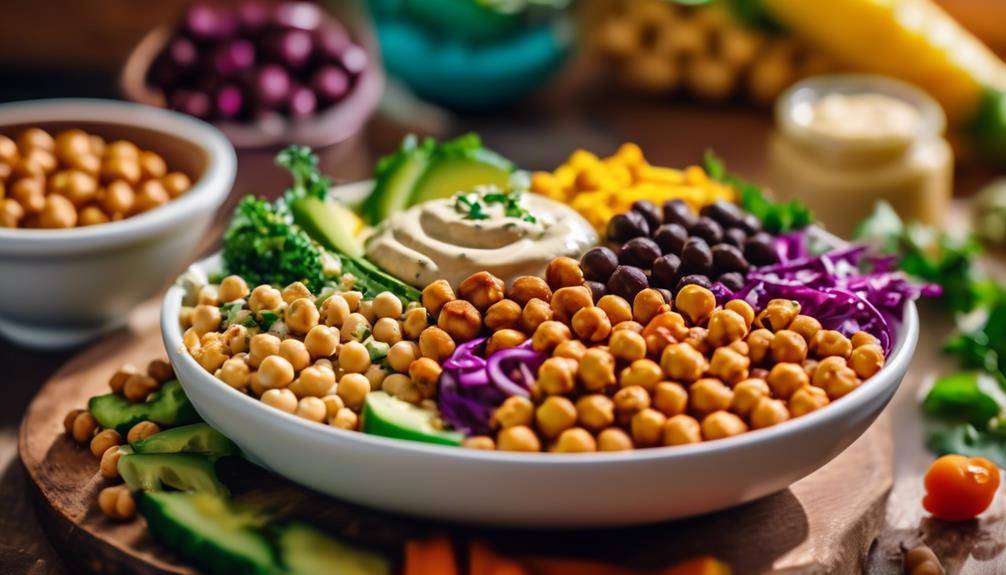Exciting Famous French Cheese Varieties

Exciting Famous French Cheese Varieties; Did you know that France produces over 1,200 varieties of cheese? From the creamy and indulgent Brie to the pungent and blue-veined Roquefort, the world of French cheese is as diverse as it is delicious. Each region of France boasts its own unique cheese, crafted with centuries of tradition and expertise. But what makes these cheeses so famous? What sets them apart from the rest? In this discussion, we will explore some of the most renowned French cheese varieties, uncovering their distinct flavors, textures, and histories. So, grab a baguette, pour yourself a glass of wine, and prepare to embark on a mouthwatering journey through the world of famous French cheeses.
Brie
Brie, a classic French cheese known for its creamy texture and rich flavor, is a favorite among cheese enthusiasts worldwide. This soft, buttery cheese is versatile and can be enjoyed in various ways. From appetizers to desserts, Brie can elevate any dish with its distinct taste and luxurious mouthfeel.
Brie recipes are abundant and varied, catering to a wide range of tastes and preferences. One popular way to enjoy Brie is by baking it. Simply wrap the cheese in puff pastry, bake until golden brown, and serve with crackers or crusty bread. The combination of the warm, melted Brie with the flaky pastry creates a heavenly appetizer that is sure to impress your guests.
But Brie is not just delicious; it also offers several health benefits. Rich in vitamins and minerals, Brie provides essential nutrients for your body. It is a good source of calcium, which is crucial for maintaining strong bones and teeth. Brie also contains vitamin B12, which is important for nerve function and the production of red blood cells. Additionally, Brie is a good source of protein, which is necessary for building and repairing tissues.
When consumed in moderation, Brie can be a part of a healthy and balanced diet. Its creamy texture and rich flavor make it a delightful addition to any meal. So, whether you’re enjoying it in a baked dish or savoring it on its own, Brie is sure to please your taste buds while providing essential nutrients for your well-being.
Camembert
Camembert, a classic French cheese, has a rich history that dates back to the late 18th century. Known for its creamy texture and earthy flavor, Camembert is a favorite among cheese lovers around the world. This soft cheese pairs well with crusty bread, fresh fruits, and a glass of wine, making it a perfect addition to any cheese board or appetizer platter.
History of Camembert
The origins of this renowned French cheese can be traced back to the 18th century Normandy region. Camembert cheese has a rich history that is closely intertwined with the cultural heritage of France. Over the years, the flavor of Camembert has evolved, developing into the creamy and aromatic cheese that we know today. The process of making Camembert involves carefully curdling the milk, followed by a period of aging to allow the flavors to develop. The cultural significance of Camembert cannot be overstated. It is often seen as a symbol of French cuisine and is enjoyed by people all over the world. Its popularity has spread far beyond the borders of France, making it a truly iconic cheese.
Flavor Profile of Camembert
With its distinct flavor and creamy texture, Camembert is a cheese that captivates the palate. Here are three key elements that contribute to the unique flavor profile of Camembert:
- Rich and Earthy: Camembert has a rich, earthy flavor that is often described as nutty or mushroom-like. This depth of flavor is a result of the cheese’s aging process, which allows the flavors to develop and intensify over time.
- Creamy and Buttery: The texture of Camembert is incredibly smooth and creamy, with a melt-in-your-mouth quality. This is due to the high fat content in the cheese, which gives it a luxurious, buttery mouthfeel.
- Slightly Tangy: Camembert has a subtle tanginess that adds a pleasant contrast to its creamy richness. This tanginess is a result of the cheese’s production process, which involves the use of specific bacteria cultures that develop during maturation.
Serving Suggestions for Camembert
To fully appreciate the indulgent flavors and creamy texture of Camembert, consider these delightful serving suggestions. Camembert is a versatile cheese that pairs well with a variety of flavors and ingredients. For a classic combination, serve it with crusty baguette slices, fresh fruits like sliced apples or grapes, and a glass of crisp white wine.
The creamy richness of Camembert also lends itself well to cooking methods like baking or grilling. Try baking a whole wheel of Camembert until it becomes gooey and melted, then serve it with crusty bread or roasted vegetables for a delicious appetizer. You can also grill thick slices of Camembert until they develop a golden crust, then serve them on top of a salad or alongside grilled meat for a decadent main course.
Roquefort
Roquefort, a beloved French cheese variety, delights with its distinct flavor and crumbly texture. This blue-veined cheese has a rich history dating back to ancient times. Here’s a closer look at the fascinating history and production process of Roquefort cheese:
- Historical Origins: Roquefort cheese can trace its roots back to the region of Aveyron in southern France. Legend has it that the cheese was accidentally discovered when a shepherd left his lunch of bread and cheese in a cave while chasing after a beautiful maiden. Upon returning weeks later, he found that the cheese had turned into Roquefort, thanks to the mold spores found in the cave.
- Unique Production Process: Roquefort is made from raw sheep’s milk, which gives it a distinctive taste. The milk is curdled using a specific type of mold called Penicillium roqueforti. After the curds are formed, they are cut, drained, and packed into molds. The cheese is then pierced with needles to allow air to enter, promoting the growth of the blue-green veins. It is aged in the natural caves of Roquefort-sur-Soulzon, where the temperature and humidity are carefully regulated.
- Protected Designation of Origin: Roquefort cheese is protected by an Appellation d’Origine Contrôlée (AOC) designation, ensuring that it can only be produced in the designated region of Roquefort-sur-Soulzon. This strict regulation ensures the quality and authenticity of Roquefort cheese.
Roquefort cheese continues to be a favorite among cheese connoisseurs worldwide. Its unique production process and rich history contribute to its esteemed reputation. So next time you indulge in this delectable cheese, savor the centuries of tradition that go into each crumbly, flavorful bite.
Comté
Comté, a renowned French cheese variety, captivates with its complex flavors and smooth, creamy texture. Made using traditional production methods, Comté is a true testament to the rich cheese-making heritage of the Franche-Comté region in eastern France. The cheese is produced using raw cow’s milk that comes exclusively from the Montbéliarde and French Simmental breeds of cows.
The aging process is a crucial step in the production of Comté. Each wheel of cheese is carefully aged for a minimum of four months, although some can be aged for up to 36 months or more. This lengthy aging process contributes to the development of its distinct taste and texture. As Comté ages, it becomes more complex, with flavors ranging from nutty and fruity to earthy and caramelized. The texture also evolves, becoming firmer and more crumbly with age.
Comté is known for its versatility and can be enjoyed in various ways. Its rich and nutty flavor makes it perfect for both savory and sweet dishes. It pairs well with fruits, nuts, and charcuterie, making it a popular choice for cheese boards. Comté is also commonly used in cooking, adding depth and richness to gratins, quiches, and fondues.
In addition to its traditional production methods and aging process, Comté has regional specialties that showcase the unique flavors of different areas within the Franche-Comté region. These specialties, known as “fruitières,” are made from milk produced in specific villages or valleys. Each fruitière imparts its own distinct character, creating a diverse range of Comté cheeses to be discovered and savored.
Comté’s combination of complex flavors, smooth texture, and regional specialties make it a beloved and celebrated cheese variety in France and beyond. Whether enjoyed on its own, paired with other ingredients, or incorporated into dishes, Comté is sure to delight cheese enthusiasts with its exceptional taste and heritage.
Gruyère
Renowned for its distinct flavor and rich heritage, Gruyère cheese captivates with its nutty undertones and smooth, creamy texture. Made in Switzerland, Gruyère stands out as one of the most beloved French cheese varieties. Let’s dive deeper into the world of Gruyère and explore its unique characteristics, cheese making techniques, and the cheese aging process.
- Distinctive Flavor: Gruyère cheese boasts a complex flavor profile that is both savory and slightly sweet. Its nutty undertones add depth and richness to every bite. This flavor is a result of the high-quality raw cow’s milk used in its production.
- Traditional Cheese Making Techniques: Gruyère cheese is crafted using traditional cheese making techniques that have been passed down through generations. The milk is first heated and curdled, then cut into small pieces. The curds are then pressed into molds to form the characteristic wheel shape. Finally, the cheese is soaked in a brine solution to enhance its flavor and texture.
- Aging Process: Gruyère cheese undergoes an extensive aging process, which contributes to its unique taste and texture. It is aged for a minimum of three months, but many varieties are aged for much longer. During this time, the cheese develops a firm yet pliable texture and its flavors mature, becoming more pronounced and complex.
Gruyère cheese is a true culinary delight, loved by cheese connoisseurs around the world. Its distinct flavor, crafted through traditional cheese making techniques, and the careful aging process result in a cheese that is truly exceptional. Whether enjoyed on its own, melted in a fondue, or grated over a dish, Gruyère adds a touch of elegance and sophistication to any culinary creation.
Munster
When it comes to Munster cheese, you’ll be delighted by its rich and distinctive flavor profile. Made from cow’s milk, this French cheese offers a creamy and tangy taste that lingers on your palate. The production process involves traditional methods, including washing the cheese with brine to develop its characteristic orange rind. To enhance your culinary experience, pair Munster with crusty bread, cured meats, and a glass of full-bodied red wine.
Flavor Profiles
Munster, a popular French cheese variety, offers a unique and distinct flavor profile that is sure to leave a lasting impression on your taste buds. Here’s what you can expect from this delicious cheese:
- Rich and Creamy: Munster has a smooth and creamy texture that melts in your mouth, giving you a luxurious taste experience.
- Earthy and Pungent: The flavor of Munster is strong and robust, with earthy undertones and a slightly pungent aroma. It has a distinct tanginess that adds depth to its overall taste.
- Nutty and Savory: This cheese has a nutty and savory flavor profile, making it perfect for pairing with fruits, nuts, and crusty bread. It also pairs well with a glass of full-bodied red wine.
Serving Suggestions:
- Enjoy Munster on a cheese platter with other French cheeses and a selection of cured meats.
- Use it as a melting cheese in dishes like quiches, gratins, or grilled sandwiches.
- Pair it with a sweet and tangy chutney for a delightful flavor combination.
Munster truly offers a unique and memorable taste experience that cheese lovers will appreciate.
Production Process
The production process of Munster cheese involves a careful combination of traditional techniques and modern methods to create its distinctive flavor and texture. The cheese making techniques used for Munster are rooted in centuries-old traditions passed down from generation to generation. The process begins with the collection of fresh cow’s milk, which is then heated and mixed with rennet, a natural enzyme that helps coagulate the milk.
Once the curds have formed, they are cut into small pieces and transferred into molds, where they are pressed to remove excess whey. The cheese is then aged for a minimum of two months, during which time it develops its characteristic pungent aroma and creamy texture. The aging process is crucial for Munster cheese, as it allows the flavors to mature and intensify. Overall, the production process of Munster cheese is a delicate balance between tradition and innovation, resulting in a truly unique and delicious cheese.
Pairing Suggestions
To enhance the rich and pungent flavors of Munster cheese, consider pairing it with a variety of complementary ingredients. Here are some pairing suggestions to help you fully enjoy this delicious cheese:
- Fresh Fruits: The sweetness of fruits like apples, pears, and grapes provides a perfect balance to the bold flavors of Munster. The crisp texture and natural sweetness of these fruits complement the creamy, tangy taste of the cheese.
- Crusty Bread: A good quality baguette or crusty bread is an ideal partner for Munster. The chewy texture and subtle flavors of the bread help to accentuate the creamy and earthy characteristics of the cheese.
- Gewürztraminer Wine: For the best wine pairing with Munster cheese, opt for a Gewürztraminer. This aromatic white wine from the Alsace region of France has floral and spicy notes that harmonize beautifully with the pungent flavors of Munster.
Bleu D’auvergne
Bleu D’auvergne, with its rich and creamy texture, is a beloved French cheese variety known for its distinctive blue veins and bold flavor. This cheese has a fascinating history that dates back to the mid-19th century. It was first created by a farmer named Antoine Roussel, who accidentally left behind a loaf of rye bread in a cave. The bread eventually developed blue mold, which Roussel then mixed with cow’s milk to create a unique cheese. This accidental discovery led to the birth of Bleu D’auvergne, which quickly gained popularity in the Auvergne region of France.
When it comes to pairing suggestions for Bleu D’auvergne, there are several options that can enhance its flavors. The strong and slightly spicy taste of this cheese pairs well with a variety of fruits, such as pears, apples, and grapes. Additionally, the creamy texture of Bleu D’auvergne is complemented by the crispness of crackers or baguette slices. For those who enjoy a glass of wine with their cheese, a full-bodied red wine, such as a Syrah or a Cabernet Sauvignon, can be a perfect match.
The bold flavors of Bleu D’auvergne make it a versatile cheese for cooking. It can be crumbled and added to salads, melted into a sauce for pasta or steak, or spread onto a sandwich for an extra kick of flavor. Its creamy yet tangy taste makes it a favorite ingredient in many dishes.
Reblochon
After exploring the fascinating history and bold flavors of Bleu D’auvergne, let’s now turn our attention to another delightful French cheese variety known as Reblochon. This semi-soft, washed-rind cheese hails from the stunning Haute-Savoie region of France and has a rich and creamy taste that is truly irresistible.
Here are three key aspects of Reblochon that make it unique:
- Reblochon Farming Techniques:
- Reblochon is made using milk from cows that graze on the lush alpine pastures of the region. These cows are primarily of the Abondance or Tarentaise breeds.
- The farmers follow traditional methods, allowing the cows to freely roam and graze on natural grasses, herbs, and flowers. This grazing technique gives the milk a distinct flavor profile.
- The cows’ diet plays a crucial role in the cheese-making process, as it imparts the characteristic nutty and herbaceous notes to the final product.
- Reblochon Cheese-Making Process:
- The cheese-making process begins with raw milk, which is gently heated in a copper cauldron. This helps maintain the natural enzymes and flavors in the milk.
- After heating, rennet and starter cultures are added to coagulate the milk. The curds are then cut and transferred to molds, where they are pressed to remove excess whey.
- The cheese is then salted, washed with brine, and aged for a minimum of three weeks. During this time, the cheese develops its distinctive orange rind and creamy interior.
Reblochon truly embodies the essence of the picturesque Haute-Savoie region. Its flavors, developed through traditional farming techniques and the cheese-making process, are a testament to the dedication of the local farmers and artisans. So, the next time you have a chance, indulge in the creamy, nutty goodness of Reblochon and experience a taste of French cheese perfection.
Saint-Nectaire
Nestled in the picturesque region of Auvergne in France, Saint-Nectaire is a delectable cheese variety that entices with its creamy texture and subtle flavors. Known for its rich history and traditional production methods, Saint-Nectaire is a true gem of French gastronomy.
The production of Saint-Nectaire follows time-honored techniques that have been passed down through generations. The cheese is made from the milk of cows that graze on the lush pastures of Auvergne. The milk is carefully collected and heated, before rennet is added to coagulate it. Once the curds have formed, they are cut, drained, and molded into the characteristic cylindrical shape of Saint-Nectaire.
After the initial stages of production, the cheese undergoes an aging process that contributes to its unique flavor profile. Traditionally, Saint-Nectaire is aged in damp cellars, where it develops a natural rind and acquires its distinct aroma. During this aging period, which typically lasts for a minimum of four weeks, the cheese matures and its flavors become more pronounced. The result is a cheese with a velvety texture and a complex blend of earthy, nutty, and slightly tangy notes.
The careful attention to detail in its production and aging process is what sets Saint-Nectaire apart. Each step in the cheese-making journey is crucial in creating a cheese that is loved by connoisseurs around the world. Whether enjoyed on its own, paired with fruits and nuts, or melted into a warm dish, Saint-Nectaire is a true delight for cheese enthusiasts seeking a taste of French excellence.
Pont-l’Évêque
Continuing our exploration of French cheese varieties, let’s now turn our attention to Pont-l’Évêque, a captivating cheese that captivates with its distinctive aroma and rich flavor profile.
- Distinctive Aroma: One of the defining characteristics of Pont-l’Évêque is its powerful aroma. As you unwrap the cheese, you’ll be greeted by a pungent scent that hints at its complex flavors. The aroma is earthy, with notes of wet straw, mushrooms, and a touch of sweetness.
- Creamy Texture: Pont-l’Évêque has a supple and creamy texture that melts in your mouth. Its semi-soft interior is smooth and slightly elastic, allowing the flavors to linger on your palate. The cheese’s velvety texture adds to its luxurious appeal.
- Flavor Profile: When it comes to taste, Pont-l’Évêque does not disappoint. Its flavor is robust, yet balanced. You’ll experience a combination of savory, tangy, and slightly sweet notes. The cheese has hints of butter, mushrooms, and even a subtle nuttiness. It pairs beautifully with a variety of accompaniments, from fresh fruit to crusty bread.
If you’re looking to incorporate Pont-l’Évêque into your recipes, there are plenty of delicious options. The cheese’s creamy texture makes it perfect for spreading on bread or crackers. You can also add it to salads, quiches, or savory tarts for an extra layer of richness. For a simple yet satisfying dish, try melting Pont-l’Évêque on top of a warm baguette and enjoy the gooey goodness.
Pont-l’Évêque is truly a cheese that delights all the senses. Its distinctive aroma, creamy texture, and rich flavor profile make it a standout choice among French cheese varieties. Whether enjoyed on its own or incorporated into a recipe, this cheese is sure to impress.
Tomme De Savoie
To truly appreciate the diverse range of French cheese varieties, one must delve into the captivating world of Tomme De Savoie. This famous French cheese is a true delight for cheese enthusiasts around the world. Tomme De Savoie is a semi-soft, pressed cheese made from cow’s milk. It originates from the mountainous region of Savoie in the French Alps, where the cows graze on lush Alpine pastures, giving the cheese a distinct and unique flavor.
Tomme De Savoie is known for its earthy and nutty taste, with a slightly tangy and creamy texture. It has a rustic, natural rind that adds to its charm. The cheese has a pale yellow interior with small, irregular holes scattered throughout. Its flavor profile intensifies as it ages, becoming more complex and flavorful.
The production process of Tomme De Savoie is a testament to the artistry and tradition of French cheese-making. The cheese is made using traditional methods, with each step carefully executed to ensure the highest quality. The milk is first heated and coagulated, and then the curds are cut and pressed. The cheese is then aged for a minimum of two months, allowing it to develop its distinctive flavor and texture.
Tomme De Savoie pairs wonderfully with a variety of foods and beverages. It complements crusty bread, cured meats, and fresh fruits. It also pairs well with light to medium-bodied red wines, such as Pinot Noir or Beaujolais. Whether enjoyed on its own or as part of a cheese platter, Tomme De Savoie is sure to satisfy even the most discerning cheese connoisseur.
Époisses
Époisses, a pungent and creamy French cheese, is revered for its rich history and distinctive flavor profile. Here is why you should know more about this amazing cheese:
- Aging process: Époisses is known for its unique aging process. After being made from raw cow’s milk, the cheese is washed with a mixture of brine and Marc de Bourgogne, a local brandy. This process encourages the growth of the bacteria responsible for its signature aroma and flavor. The cheese is then aged for about six weeks, during which it develops a soft, orange rind and a creamy, gooey interior.
- Distinctive flavor profile: The flavor of Époisses is complex and intense. It has a creamy, melt-in-your-mouth texture with a salty, slightly tangy taste. As it ages, the cheese becomes softer and more pungent, developing earthy and meaty notes. The rind adds a touch of bitterness and a nutty aroma. The combination of these flavors makes Époisses a true delicacy.
- Wine pairings: To fully appreciate the flavors of Époisses, it is best enjoyed with the right wine. The cheese’s boldness pairs well with full-bodied red wines, such as Burgundy or Bordeaux. The tannins in these wines complement the richness of Époisses and balance its pungency. For a more contrasting pairing, try a sweet white wine, like Sauternes, which cuts through the cheese’s creaminess and enhances its savory elements.
Époisses is a cheese that demands attention and respect for its intricate aging process, distinctive flavors, and perfect wine pairings. Its pungent aroma and creamy texture make it a delight for cheese connoisseurs and a must-try for anyone seeking an authentic French culinary experience.
Fourme D’ambert
After exploring the pungent and creamy depths of Époisses, it’s time to embark on a new culinary adventure with the delectable Fourme D’ambert. This famous French cheese, known for its distinct cylindrical shape and blue veining, is a true delight for cheese connoisseurs.
Fourme D’ambert is made from cow’s milk and hails from the Auvergne region of France. Its name is derived from the Latin word “forma,” meaning shape, which perfectly describes its traditional form. The cheese is aged for a minimum of 28 days, allowing its flavors to develop and intensify.
One characteristic that sets Fourme D’ambert apart is its creamy and slightly crumbly texture. As you take a bite, the cheese melts in your mouth, leaving behind a rich and nutty flavor with hints of earthy undertones. The blue veining adds a tangy and slightly spicy note, balancing the overall taste profile.
When it comes to pairings, Fourme D’ambert shines in both sweet and savory combinations. It pairs beautifully with fresh pears, figs, and honey, as their sweetness complements the cheese’s creaminess. For a more savory experience, enjoy it with crusty bread, walnuts, or cured meats like prosciutto.
Whether you’re a seasoned cheese lover or just beginning your cheese journey, Fourme D’ambert is a must-try. Its unique flavor profile and velvety texture make it a standout among famous French cheeses. So, indulge in this culinary masterpiece and savor the exquisite taste of Fourme D’ambert.
Frequently Asked Questions: Exciting Famous French Cheese Varieties
What Is the History Behind the Production of Brie, Camembert, Roquefort, Comté, Gruyère, Munster, Bleu D’auvergne, Reblochon, Saint-Nectaire, Pont-L’évêque, Tomme De Savoie, Époisses, and Fourme D’ambert?
How did the production of famous French cheeses contribute to the economy? What role did French culinary traditions play in the development of these cheese varieties? Find out the fascinating history behind these iconic cheeses and their impact on the economy and culinary traditions.
Are There Any Particular Regions in France Known for Producing These Famous Cheese Varieties?
There are indeed particular regions in France known for producing these famous cheese varieties. The production history of these cheeses is deeply rooted in the traditions and expertise of these regions.
What Are Some Popular Dishes or Recipes That Incorporate Brie, Camembert, Roquefort, Comté, Gruyère, Munster, Bleu D’auvergne, Reblochon, Saint-Nectaire, Pont-L’évêque, Tomme De Savoie, Époisses, and Fourme D’ambert?
Popular French cheese recipes include dishes like brie en croûte, camembert fondue, and roquefort salad dressing. These cheeses can also be paired with wine, such as brie with champagne or camembert with a dry white wine.
Can These French Cheeses Be Easily Found and Purchased Outside of France?
French cheeses like brie, camembert, roquefort, and more are widely available and popular in international markets due to globalization. You can easily find and purchase these delicious cheeses outside of France. Enjoy!
Are There Any Specific Guidelines or Recommendations for Storing and Serving Brie, Camembert, Roquefort, Comté, Gruyère, Munster, Bleu D’auvergne, Reblochon, Saint-Nectaire, Pont-L’évêque
When it comes to storing and serving famous French cheeses like brie, camembert, roquefort, and more, there are specific guidelines and recommendations. Additionally, while these cheeses may be available outside of France, their availability may vary.
Conclusion
In conclusion, the world of French cheese is a treasure trove of flavors and textures. From the creamy and mild Brie and Camembert to the tangy and pungent Roquefort, there is something for every cheese lover. The Comté and Gruyère offer a nutty and savory experience, while Pont-l’Évêque and Tomme De Savoie showcase the diversity of French cheese. For those seeking a bold and intense taste, Époisses and Fourme D’ambert are the perfect choices. Indulge in these famous varieties and let your taste buds embark on a delightful journey.







